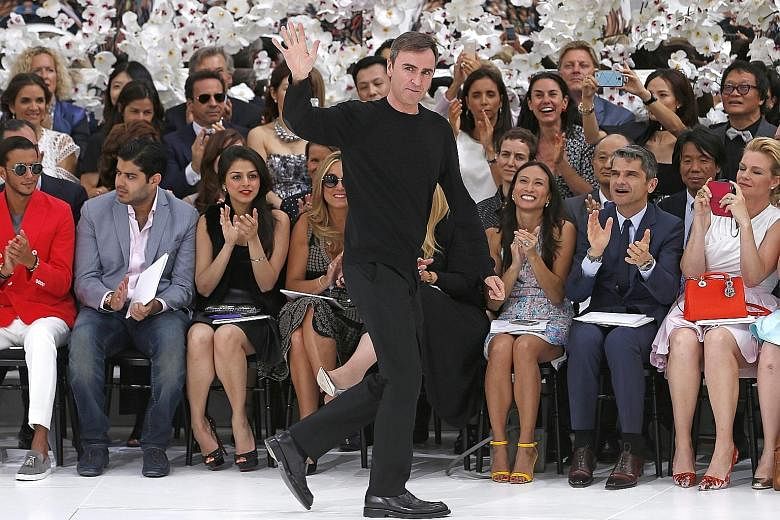NEW YORK • Calvin Klein named its first chief creative officer on Tuesday as the fashion industry's extraordinary game of musical chairs at the top of major houses continues this season.
Belgian designer Raf Simons, 48, formerly of Christian Dior, will take responsibility for all Calvin Klein lines, including runway, underwear and home goods collections. His appointment consolidates creative control of the company, which has not had just one such vision since its founder sold the brand in 2002.
At a time when the New York fashion scene lacks direction, Simons' appointment at the top level of one of America's most resonant brands is a potential game- changer for the industry.
Mr Steve Shiffman, the company's chief executive, said in a statement first published on Facebook: "Raf's exceptional contributions have shaped and modernised fashion as we see it today and, under his direction, Calvin Klein will further solidify its position as a leading global lifestyle brand."
Though widely expected by the fashion world since Simons resigned as creative director at Dior in October, the appointment heralds a major strategy shift at Calvin Klein, which is owned by PVH.
The move may also be a riposte of sorts to those who seized on Simons' departure from Dior as a chance to deplore the state of fashion for demanding too much of designers. The need to do six collections a year - not atypical in the industry - at Dior was seen as a millstone around the neck of creativity.
Calvin Klein has not had a single creative chief since it was sold to PVH for US$430 million in cash and stock, not including royalties. After Klein left, one designer, Francisco Costa, led the women's collection; another, Italo Zucchelli, led men's; and Kevin Carrigan was in charge of jeans and underwear.
Though this transferred power from the designers to the brand and Calvin Klein remained a commercial force, its aesthetic identity and influence were greatly diminished.
The catwalk lines themselves, which were hard to find in stores beyond the brand's own and which were once categorised by former chief executive Tom Murry as "a marketing expense", seemed almost incidental. Sales accounted for less than 5 per cent of the business.
Most attempts to make a statement, such as a recent advertisement campaign featuring singer Justin Bieber and model Kendall Jenner, were more a retread of old ideas (Marky Mark and Kate Moss) than a contemporary vision.
Klein himself became openly critical of the approach, telling talk-show host Andy Cohen in a SiriusXM town hall in June: "It's been a long time since I saw something exciting."
Apparently Mr Shiffman, who was appointed Calvin Klein's chief executive in 2014, agreed and, in April, Costa and Zucchelli left the brand, making way for Simons, who reportedly had a non-compete agreement with Dior that prevented him from joining Calvin Klein until this month.
Calvin Klein had sales of US$8.2 billion (S$11 billion) last year and has publicly declared its ambitions to grow to US$10 billion.
Simons will "oversee all aspects of design, global marketing and communications, and visual creative services", the company said. And his long-term collaborator, Pieter Mulier, was named Calvin Klein's creative director.
A fashion world favourite and trained industrial designer who in 1995 started a menswear line that bears his name, Simons began his career in womenswear as creative director of Jil Sander. He moved quickly to put his own modernist stamp on that brand, before joining Dior and doing the same in 2012.
He is known for an intellectual, architectural approach to form.
His appointment at Calvin Klein is an acknowledgment of the need for a defining, and unifying, creative point of view for a brand. In a time of geopolitical unrest and challenged consumption patterns, a line must stand for something to stand out. That will be Simons' charge.
If he can achieve it, he will help refocus New York fashion, which has been in something of a creative vacuum in recent years, casting about for a post-sportswear identity.
It is an enormous opportunity and challenge. Not the kind of challenge that a designer who is searching for more time to smell the daisies would take on - especially given the fact that Simons, who has relocated to New York from Antwerp, Belgium, will continue to design his own men's line at the same time.
The fact that Simons has stepped into this role at Calvin Klein suggests that perhaps his departure from Dior had more to do with the limitations he found in that job (his responsibility was limited to womenswear and accessories) than with any design pressure. And that it is not the creative demands the fashion industry places on its designers that is creating unrest in the industry, but rather the continuing power struggle between brand and individual.
In this case, the pendulum has swung back towards the person.
If Simons can make Calvin Klein again a key name in the life of women and their wardrobes, it may change conventional wisdom, which since Tom Ford left Gucci in 2004, has held the brand above all.
The first test will come early next year, when Simons presents his men and women's autumn collections for Calvin Klein.
NEW YORK TIMES

